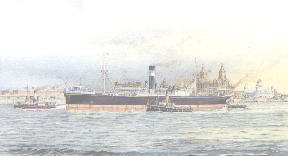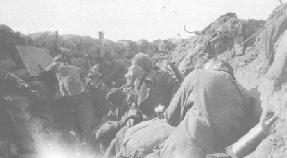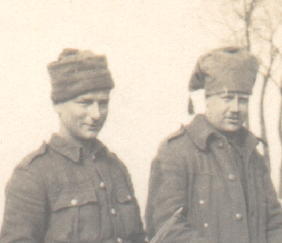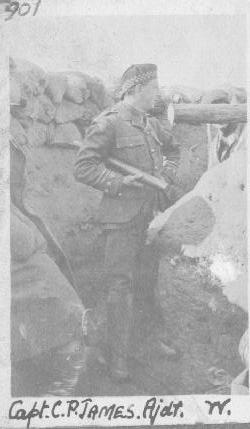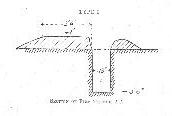The Liverpool Scottish - Trench Life Through the Great War
Contact the Liverpool Scottish Regimental Museum
Main Museum page (in this window) Previous Trail Page Next Trail Page Exhibition Entrance
'The Superficial and the Essential'
Autumn 1914
Move to the Trenches- The Context
-
The SS Maidan on which the Liverpool Scottish sailed to France pictures in the Mersey Account of the voyage
- Infantry = Front line foot soldiers
- Battalion = about 1000 infantry soldiers (1914)
- Territorial Force = Army reserve made up of civilians with an ordinary day job but who did military training at weekends. Today, they are known as the Territorial Army.
- British Expeditionary Force = The original contingent of soldiers sent to France to oppose the German invasion of Belgium in August 1914
- The Liverpool Scottish was a Territorial Force infantry battalion [10th (Scottish) Battalion, The King's (Liverpool Regiment) T.F]. The Liverpool Scottish Regimental Museum main website is at www.liverpoolscottish.org.uk
-
New boots ... would take time to break in and since the soldiers had to march nearly everywhere, this would be very painful for their feet and might make a soldier unfit for service. The battalion had gone to France equipped with shoes and gaiters, shoes which would be pulled off in the mud. The battalion's doctor was Captain Noel Chavasse, later to win the the Victoria Cross twice, and he took great trouble with the care of men's feet.
- The Liverpool Scottish
move toward the Trenches in Belgium. November 19th 1914 - the Diary of
Captain Bryden McKinnell:
- "Battalion returned early very wet. Everything now became one wild rush, as we had to get and fit 400 boots, besides coats, tunics etc. we indented weeks ago for the stuff , but they never let you have things until you are absolutely going..... This has caused untold inconvenience, and the men had to march off with new boots"
- The Liverpool Scottish sailed to France from Southampton aboard the SS Maidan (above) on 1st November 1914, about three months after the outbreak of the First World War. They were one of the first infantry battalions of the Territorial Force to join the British Expeditionary Force. They were 'called up' for war service in August 1914. By the end of November 1914 they were in the 'trenches'.
-
November 22nd 1914 - Diary of Captain Bryden McKinnell
-
"Met several [regular] officers coming home for their first leave wildly excited. They had been right there from the beginning. {August 1914}..... I noticed they carried all their kit in a small haversack. They looked very clean considering. Our kit has been getting gradually less"
- "Our kit has been getting gradually less"
... The evidence from the diary suggests that the
Territorials are learning quickly how to live in war by reducing the
kit that they carried.
 The officers took their swords to
France in 1914 (as the Regular Army had done in August). They were quickly put into store [Regimental History].
In the photo detail on the left, taken at Tunbridge Wells in October
1914, Lt Kendall of the Liverpool Scottish can be seen with the
uniform he would wear in the field with his sword hilt at his left
hip. Click on the photo or here
to see all the officers and note the kilt aprons worn to protect and
camouflage the kilt which was worn throughout the fighting of the
Great War.
The officers took their swords to
France in 1914 (as the Regular Army had done in August). They were quickly put into store [Regimental History].
In the photo detail on the left, taken at Tunbridge Wells in October
1914, Lt Kendall of the Liverpool Scottish can be seen with the
uniform he would wear in the field with his sword hilt at his left
hip. Click on the photo or here
to see all the officers and note the kilt aprons worn to protect and
camouflage the kilt which was worn throughout the fighting of the
Great War.
- They arrived when the 'Old Contemptibles' of the
Regular Army (full time soldiers and, according to the German Kaiser
Wilhelm, a 'contemptible little army' ) had fought alongside the
French and the Belgians in a highly mobile battle which finally
stopped the Germans in September 1914.
- The Liverpool Scottish joined the 3rd Division of II Corps (both formations were part of the Regular Army) and was initially addressed by the Corps Commander, General Sir H. Smith Dorrien, to the effect that, with the co-operation of the Russians, the war would be over by the summer of 1915. The Regimental Historian records that newly-arrived citizen soldiers of The Scottish 'were surprised to learn that the Staff expected the war to last so long'.
-
Company = at full strength about 200 infantry soldiers (the Army had just gone from smaller companies of about 100 to 'double-companies' of about 200. There were four of the larger companies to a battalion
-
Regulars = Soldiers of the Regular (full time) army who in would have been likely to have been through two months hard fighting.
-
Cap-comforter = a shapeless woolen tube with closed ends which can be formed into a hat or a scarf (still in use today).
-
Tommy = 'Tommy Atkins', a traditional name for a British soldier
- Late November 1914
Liverpool Scottish Regimental History - Colonel A.M.McGilchrist
- "The first sight the [Liverpool Scottish] had of a company of Regulars on the march was something of a shock. Many of the men had beards, their clothing was stained and muddy and quite a number were wearing cap-comforters instead of the regulation flat cap. Anything more unlike the traditional smart Tommy it would be difficult to imagine. But there was one thing about them that did particularly attract the eye. Every man's rifle was absolutely spotless, not a bad illustration for civilian soldiers of the distinction between the superficial and the essential'
A Side Gallery Here
-
It would not be too long before the Liverpool Scottish themselves had adapted their dress to the realities of trench warfare as this photo of Sgt DAB Marples (right) shows
-
The picture of the Adjutant, Captain CP James, in the trenches in early 1915 has an informal touch to it
-
26th November 1914 - The Regimental History - Colonel A.M. McGilchrist
-
"[The Brigade Major] explained the [early] principles of trench warfare ... and issued instructions for routine to be carried out in the line. Some of these, in the light of later experience, were rather humorous. .... "In the front line there will be no smoking whatever, and no matches will be struck" and "Day and night, every other man will be on sentry duty".
-
The Brigade Major = a staff officer from Brigade HQ. Carried out the the detail of Brigade Commander's [a Brigadier-General] orders.
-
Brigade = In the infantry of 1914, normally four battalions with the support of guns from the Royal Field Artillery
-
'No smoking' = a lighted cigarette can be seen from a long distance but the evidence of the writer suggests that this and the other instructions were completely impractical in the circumstances of trench warfare.
-
Sentry duty = Soldier responsible for keeping watch. A duty of '1 in 2' or 'every other man' is a very burden and would be impractical as men were needed to help with barbed wire, patrolling in front of the trenches, carrying stores and cooking and sleeping.
-
Basic Fire Trench (see left) = Standard trench dug by soldiers to give cover from enemy rifle and shell fire. There is more on this on the next page.
- The Liverpool Scottish went into the trenches for the first time on 27th November 1914. The Regular Army would have been very concerned about a battalion of unknown part-time territorial soldiers with no experience of warfare joining them. At home in the United Kingdom, the Secretary of State for War [Lord Kitchener, a very famous soldier] preferred to raise a whole new army from scratch rather than rely on the Territorial Force which he considered to be of very variable quality. This would in fact become known as 'The New Army' and would be tried in the Battle of the Somme in 1916, but not before the Territorials had proved themselves.
